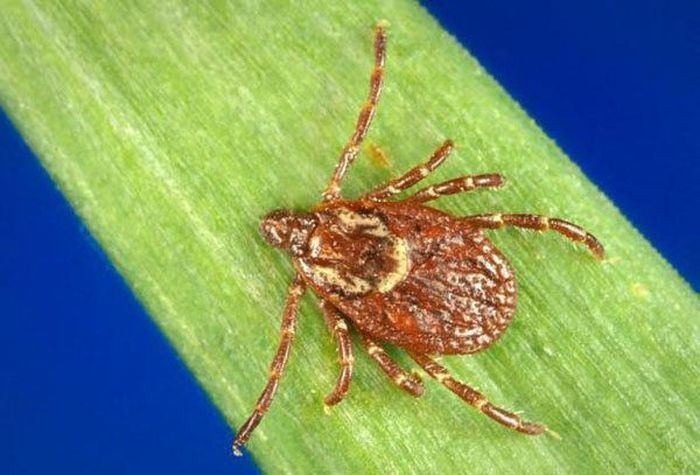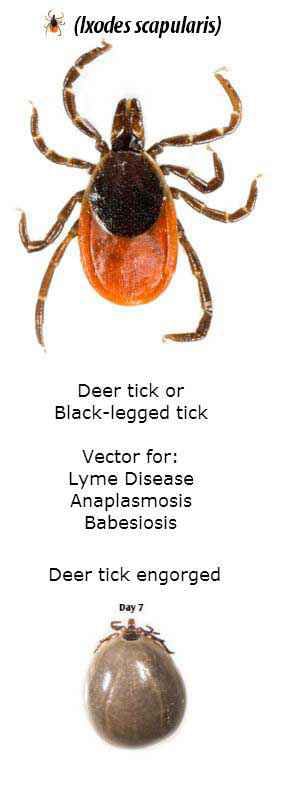Common Ticks in Ohio

Lately, I have been hearing people say how they are finding ticks on their pets. While the prime time for ticks lasts from spring to early fall, it is not uncommon to see them during the colder months. Ticks are parasitic arachnids that need a host to survive and breed. Adult ticks are approximately 3-5mm in length. As they suck the host's blood, they dig under the skin and hang out for a few days.
Did you know that there are over 800 different types of ticks?! In this blog, I will go over the ticks that are common in Ohio and which ones carry harmful diseases.
American Dog Tick
The American Dog tick, the most encountered tick in Ohio, live in open fields and areas with tall grass and little tree cover. This is the largest tick in Ohio. Both males and females have red-brown legs and bodies. These ticks can transmit Rocky Mountain spotted fever; a rare infectious disease caused by the bacterium Francisella tularensis. Symptoms include fevers, headache, rash, nausea, vomiting, muscle pain, stomach pain, and lack of appetite. While not common, this disease can cause death if not treated quickly.
Winter Tick
Commonly know as a moose tick, the Winter tick is unlikely to bite humans. Instead, they feast on larger animals like moose, deer, cattle, and horses - hence the nickname. These ticks are unique because they remain active in the fall and winter months. Winter ticks are red-brown in color with narrow, long bodies and small mouthparts. Most often encountered by hunters when taking wild game, these ticks can kill a moose by overpowering it with their size of infestation. Moose have been found with up to 70,000 winter ticks embedded in their skin.
Deer Tick

Deer ticks, also known as black-legged ticks, are the only ticks in Ohio with black legs. Males have red-brown bodies, while females have almost orange bodies and black scuta (bony external plate). Deer ticks are common in woodlands and the edges between forests and open fields. When they are in the larva and nymph stage, deer ticks feed on mice, rats, squirrels, and other small mammals. Unfortunately, feeding on mice is how they contract the bacteria responsible for Lyme disease. As adults, they are then capable of transmitting this bacterial infection to dogs and humans. Lyme disease presents many of the same symptoms as other tick-borne diseases but is often accompanied by a bulls-eye rash at the site of a bite. These rashes typically appear within one to two weeks of infection. Prompt treatment with antibiotics can cure the infection, but long-term symptoms may persist if the infection is not caught early. If you suspect you have been bitten by a deer tick, be sure to save it to send off to a tick lab for testing. The tests will determine whether or not the tick carried Lyme disease and can help you be proactive in your treatment.
Lonestar Tick
The Lonestar tick is very aggressive and are known to bite humans. While they are found in the majority of Ohio, they are most prominent in the Southern half of the state. The Lonestar tick can be easily identified by the single white spot on the back of an adult female. Commonly found in the woodlands and undergrowth, they feed on squirrels, raccoons, deer, cattle, and some bird and dog species. The Lonestar tick is known to transmit Ehrlichiosis, as well as a number of other infectious diseases. Ehrlichiosis causes flu-like symptoms and normally shows up within two weeks if the tick had been feeding on you for more than 24 hours. The illness can be treated with antibiotics but has the potential to be more serious in people with poor immune systems.
Brown Dog Ticks
Brown Dog Ticks are another type of dog tick found in Ohio. They spend most of their lives indoors, where they feed almost exclusively on dogs. Brown Dog ticks have narrow, medium brown bodies with little sexual dimorphism. While bites to humans are rare, they can spread Rocky Mountain Spotted Fever just like American Dog ticks. They also carry several canine-specific pathogens.
How to Avoid Tick Bites
Other than the obvious choice of avoiding wooded and brushy areas with high grass and leaf litter, wearing long sleeves and pants is one of the best ways to protect yourself. Additionally, wearing light-colored clothes can help you spot ticks more easily. There are also repellents available to use on your skin and clothing.
If you see ticks on your clothes, remove them before going inside. You can wash your clothes in hot water, or put them in the dryer on high heat for 10 minutes to kill ticks.
Once inside, it is recommended to shower within two hours to rid yourself of any ticks that may still be on your body. Use a mirror to do a full-body check, making sure to carefully inspect areas such as the back of knees, the groin, the waistband, armpits, in and behind the ears and on the scalp.
If You Get Bitten By A Tick
The safest way to remove a tick is with tweezers. Hold the tweezers parallel to the skin and grasp the tick firmly by the head as close to your skin as possible. Apply firm but gentle pressure and pull the tick straight up and out. Do not jerk or twist the tick when removing it, and do not crush the tick with your fingers. After removal, you will need to wash the bite and apply an antiseptic.
If only part of the tick comes out, or the head remains embedded in your skin, try to remove the head with tweezers. If most or all of the head remains in your skin, contact your doctor.
As mentioned earlier, you should save the tick for testing. You can contact your local board of health to help with tick identification and possible testing.
If you notice flu-like symptoms, a rash, joint swelling, or other tick-bite symptoms developing, contact your doctor immediately.
If Your Pet Gets Bitten By A Tick
In dogs, tick bites can cause many of the same illnesses as in people. Tick-borne illnesses are less common in cats; however, they can contract a life-threatening illness called Cytauxzoonosis, from ticks.
If your cat or dog is bitten by a tick, remove it with tweezers in the same way you would remove it from yourself. Keep an eye out for symptoms of illness and contact your veterinarian if you notice any lethargy, loss of appetite, pale gums, fever, vomiting, lameness or seizures. If you are able, save the tick for testing.
For further information, please visit the links below:
https://u.osu.edu/biomuseum/2017/04/03/know-your-ticks-ohio
https://ohioline.osu.edu/factsheet/HYG-2073